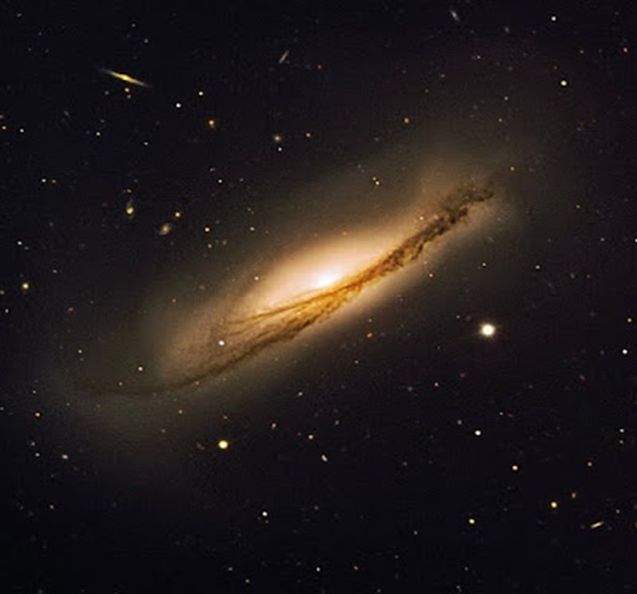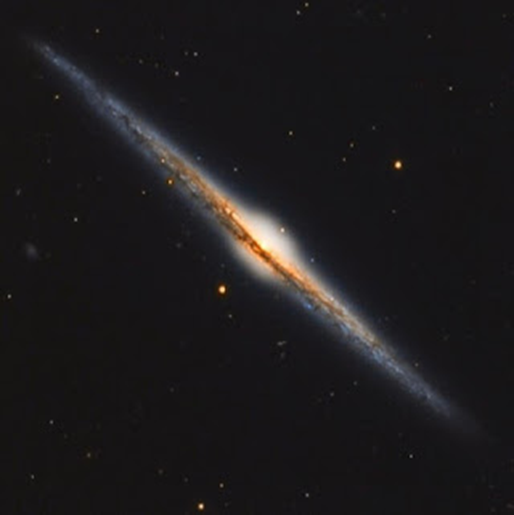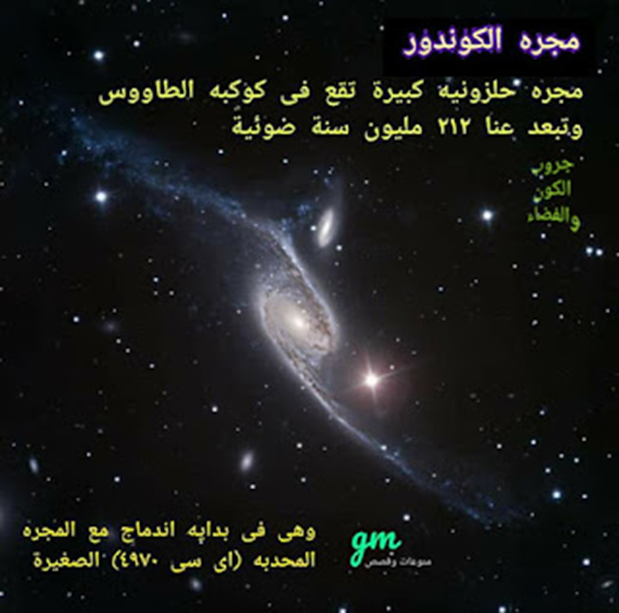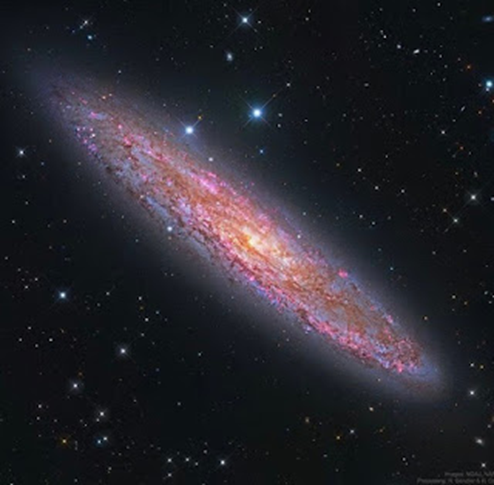Galaxies cosmic islands

1- definition of galaxies
Before answering the question of what types of galaxies are, we will talk about the galaxies themselves,
where galaxies are known as huge sprawling gatherings of dust, gas, stars and dark matter,
and some of the galaxies of the universe are similar to the galaxy in which humans are located, which is known as the Milky Way,
and other galaxies It differs significantly from the Milky Way , and
according to studies conducted in 2016, it was found that the observable universe contains two trillion or two million million galaxies,
and it was found that most large galaxies often contain in their centers supermassive black holes,
and in the following we will talk about what are types of galaxies.
2 - Age of Galaxies
Before identifying what types of galaxies are, we will talk about the age of galaxies
. Although most galaxies have a different history, most of them, if not all of them have the same age,
where the age of galaxies is measured by measuring the ages of the oldest stars inside them, for example For example, the age of the Milky Way is equivalent to about 13 billion years,
and when looking at the distant galaxies it is possible to notice the great similarity in their spectra and colors with the nearby galaxies, which indicates that it contains a group of very similar old stars, and as a result of this information it is possible that all galaxies are They began to form at the same time,
and thus all of them began to form stars at the same time. It can also be said that the difference between galaxies and their composition is not a matter of age, but lies in the way the stars were formed.
3 - The size of galaxies
Before answering the question, what are the types of galaxies, the size and mass of galaxies will be known, as the true size of galaxies ranges between extreme dwarf galaxies, which are the smallest galaxies, and giant radio galaxies, which are the largest,
as the diameter of the extreme dwarf galaxies located near the Milky Way does not exceed More than 100 light-years, while giant radio galaxies may extend to more than three million light-years, and some large spiral galaxies such as the Andromeda galaxy range between 100,000 and 500,000 light-years in diameter.
It is not possible to determine the masses of galaxies with certainty, due to the invisible nature of the dark halos that surround galaxies.
Unfortunately, the majority of the mass of galaxies is of unknown nature, but the total mass of material in the radius of the galaxy in which stars or galactic gases appear can be measured by many systems, and the masses of galaxies range from 100,000 to about 1,000,000,000, 000 times the mass of the Sun.
4 - Structure of galaxiesGalaxies cosmic islands

Before getting to know what types of galaxies are, we will talk about the structure of galaxies, as the structure of galaxies is formed from four basic parts, which are
the spherical
component, the disk component, the
spiral arms, and the
distribution of gas,
and in the following we will talk about these four basic components of galaxies:
spherical component:
It is a structure of ancient stars arranged in an oval shape, with most or all galaxies having a spherical component, and the spherical component of all galaxies is usually very similar, and in some cases this component may be unclear or absent altogether.
disk component:
It is a part of some types of galaxies such as spiral galaxies such as the Milky Way and irregular galaxies, and this disk usually contains gas, cosmic dust and new stars, and the center of the disk is the center of the galaxy.
Arms of Galaxies:
The general structure of spiral arms depends on the type of galaxy. Some galaxies have smooth spiral arms with small angles, while other groups of galaxies have more open arms with large angles.
Gas Distribution:
Neutral hydrogen gas is common in galaxies, but molecular hydrogen is difficult to detect, but it is usually combined with other molecules such as carbon monoxide, which can be observed at radio wavelengths.
What are the types of galaxies? After talking about galaxies, their age, size and structure, the question will be answered
types of galaxies

Galaxies cosmic islands
Where the ancient astronomers identified the types of galaxies by their shapes only, and with the development of science and the advent of the telescope, scientists were able to determine the types of galaxies depending on their shape along with some data and information acquired about the stars and their movement, and in the following, the question will be answered: What are the types of galaxies:
spiral galaxies

Galaxies cosmic islands
Spiral galaxies are the most famous type of galaxies. These galaxies are shaped like a flat disk and spiral arms extending away from the galaxy's core. They also have a central bulge that houses a massive black hole. Some of these galaxies also have a band that runs through the center. Serves as a conduit for transporting gas, dust and stars.
elliptical galaxies
The shape of these galaxies ranges from spherical to elliptical, and these galaxies are characterized by containing large amounts of dark matter, as well as small amounts of gas and dust. It is believed that these galaxies arose from the collision of two or more spiral galaxies with each other.
irregular galaxies

Where these galaxies constitute about a quarter of the universe’s galaxies, astronomers refer to them as strange or irregular galaxies because of their strange shapes, and some scientists believe that the reason for this appearance of irregular galaxies is the occurrence of distortions caused by a nearby or passing huge galaxy near this type of galaxy. Galaxies.
lenticular galaxiesGalaxies cosmic islands
Where these galaxies contain both spiral and elliptical galaxies together, these galaxies are still being studied, and many scientists are working on conducting special studies and research on the origins of these lenticular galaxies, and this type of galaxy is also known as convex galaxies, which is part of the answer To the question what are the types of galaxies
, special types of galaxies, after learning about what types of galaxies are, some will be identified,
Special types of galaxies
Where the universe contains special groups of galaxies that differ in shape and some characteristics that distinguish them from each other, as these characteristics help astronomers to classify galaxies in an expanded manner within their general classifications, and in the following, some special types of galaxies will be identified, which is a complementary answer to the question What are the types of galaxies:
dwarf galaxies
It is one of the smallest types of galaxies, and some of these galaxies exist in flat shapes referred to as spherical dwarfs, but it is difficult to identify this type of galaxy from ordinary galaxies because there are no clear definitions and characteristics that make one galaxies dwarfs and the other normal.
star galaxies

Galaxies cosmic islands
They are galaxies that are more active in the formation of new stars compared to other galaxies. These galaxies are characterized by the rapid formation of new stars, and scientists believe that these stars arose as a result of galaxy collisions and the interactions that the stellar galaxy undergoes.
Active galaxies: These galaxies contain an active black hole, which pushes large amounts of energy out of the galaxy, and despite extensive studies about these galaxies, the sudden activity of these holes is still a secret that has not been discovered yet, and this hole sends rays X-rays and radio emissions can be detected on the surface of the Earth, and this is the last type that will be talked about in answering the question of what types of galaxies are.
Galactic Clusters
After answering the question what are the types of galaxies and what are the special types of galaxies, we will talk about galactic clusters, as scientists were able to identify different galactic clusters, as these clusters are divided into three categories, namely; Groups, irregular gatherings and spherical gatherings, and in the following we will talk about these three gatherings:
groups:
Where this class of groups is formed from a small group consisting of between 10 to 50 different galaxies, and these groups extend to about five million light-years, and these groups include about 50 systems, most of which consist of a variety of dwarf galaxies.
Irregular pools:

Galaxies cosmic islands
They are huge assemblies of irregular galaxies of different types of galaxies, and usually most of this type of grouping consists of spiral galaxies and elliptical galaxies, and the total of these groupings reaches a thousand systems extending from 10 million to 50 million light-years. Globular clusters: Most of this type of cluster consists of enormous elliptical galaxies, with a diameter of about 50 million light-years, and globular clusters may contain more than 10,000 galaxies, most of which are concentrated in the center of the cluster.
Galactic evolution
The process of evolution of galaxies is greatly affected by interactions and collisions with other galaxies, the process of merging galaxies was common during the early era, and the majority of galaxies were strange in formation and evolution, however, due to the large distances between stars, the vast majority of star systems will not be affected when colliding, except Gravitational erosion of interstellar gas and dust produces long trails of stars known as tidal tails.
Milky Way

Galaxies cosmic islands
After answering the question what are the types of galaxies, we will talk about the Milky Way in detail, as the Milky Way is the most important galaxies that exist for humans, and the reason for that is because it is the only home for humans, and it is a spiral galaxy that extends to about 100,000 light years, If it is possible to look at the Milky Way from above, a central bulge will be seen surrounded by four large spiral arms, as the solar system is located on the edges of one of the arms of this galaxy, and this arm containing the solar system is called the Orion arm, as this arm is located between two main arms They are Sagittarius and Perseus, as this galaxy constantly rotates in space, and thus the solar system rotates with this galaxy at a speed equivalent to 515,000 miles per hour.
The Milky Way is surrounded by a huge halo of hot gas that spans hundreds of thousands of light-years, and the spiral arms contain large amounts of dust and gas, as new stars are constantly emerging within these arms, and the Milky Way also contains a giant black hole located in the center of the galaxy. , where the size of this black hole is billions of times the size of the sun, and the mass of the galaxy was measured and it ranged between 400 and 780 billion times the mass of the sun,
and in the following we will talk about some facts related to the Milky Way:
Facts about the Milky Way
The Milky Way contains more than 200 billion stars. The solar system is located 30,000 light-years away from the galactic center. The oldest stars in the Milky Way are older than the Sun in the Solar System. Red dwarfs are the most common stars in the galaxy. The strangest cosmic galaxies After identifying the types of galaxies, the strangest cosmic galaxies will be identified
strange galaxies
Where the universe contains strange-shaped galaxies that may resemble jellyfish, and there are some galaxies that consume other galaxies and galaxies that lack dark matter that spread throughout the universe, and in the following, some of these strange galaxies will be identified:
Jellyfish Galaxy:
It is a spiral galaxy in the form of a jellyfish floating in space, where stars are formed in this galaxy within a tail consisting of dust and gas.
dead galaxy:

It is a massive galaxy in the form of a disk, spinning at a speed equal to twice the speed of the Milky Way, but it is an inactive galaxy, as it has not made stars in 10 billion years.
The cannibal galaxy:
It is a giant galaxy that devours galaxies smaller than it, and studies have confirmed that this galaxy will collide with the Milky Way within 4.5 billion years.
eye galaxy:

Galaxies cosmic islands
It is a spiral galaxy consisting of a huge amount of stars and dust, as this galaxy appears in the form of an eye swimming in space.
Flower Galaxy: It is a mixture between a spiral galaxy and an extended elliptical galaxy, as this galaxy resembles a petal that swims in space, and this galaxy is located 270 million light years from Earth
https://999space.blogspot.com/2021/01/blog-post_24.html?fbclid=IwAR2bIlDyn2_5YNsAkw2SPzdH5sSbJ1EXjSJ9bHejCQBbyOzp6oP4pqVQh-4

